2017 Peugeot 3008 Hybrid 4 seats
[x] Cancel search: seatsPage 139 of 578
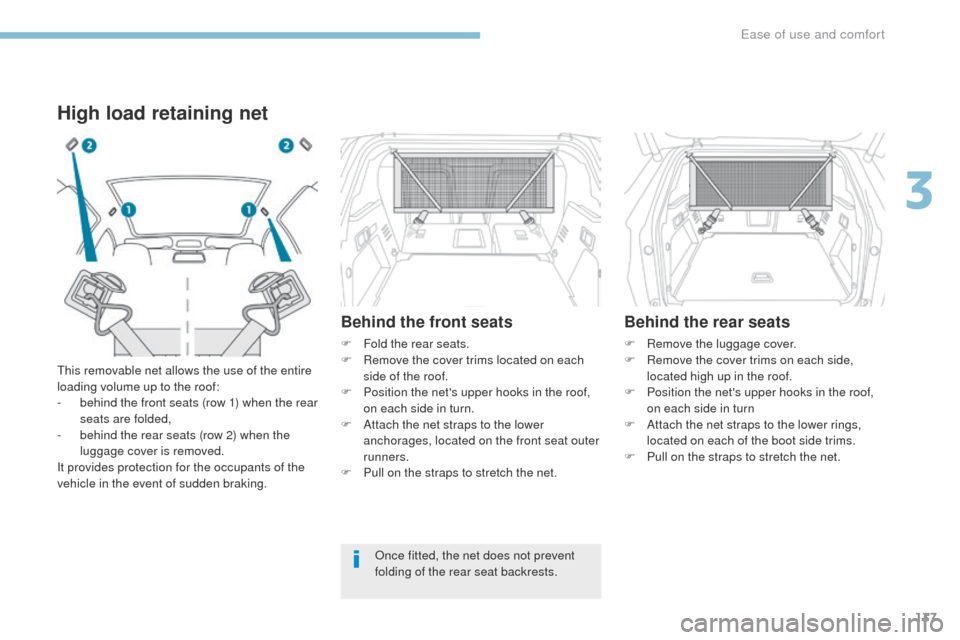
137
3008-2_en_Chap03_ergonomie-et-confort_ed01-2016
High load retaining net
This removable net allows the use of the entire
loading volume up to the roof:
-
b
ehind the front seats (row 1) when the rear
seats are folded,
-
b
ehind the rear seats (row 2) when the
luggage cover is removed.
It provides protection for the occupants of the
vehicle in the event of sudden braking.
Behind the front seats
F Fold the rear seats.
F R emove the cover trims located on each
side of the roof.
F
P
osition the net's upper hooks in the roof,
on each side in turn.
F
A
ttach the net straps to the lower
anchorages, located on the front seat outer
runners.
F
P
ull on the straps to stretch the net.
Behind the rear seats
F Remove the luggage cover.
F R emove the cover trims on each side,
located high up in the roof.
F
P
osition the net's upper hooks in the roof,
on each side in turn
F
A
ttach the net straps to the lower rings,
located on each of the boot side trims.
F
P
ull on the straps to stretch the net.
Once fitted, the net does not prevent
folding of the rear seat backrests.
3
Ease of use and comfort
Page 140 of 578
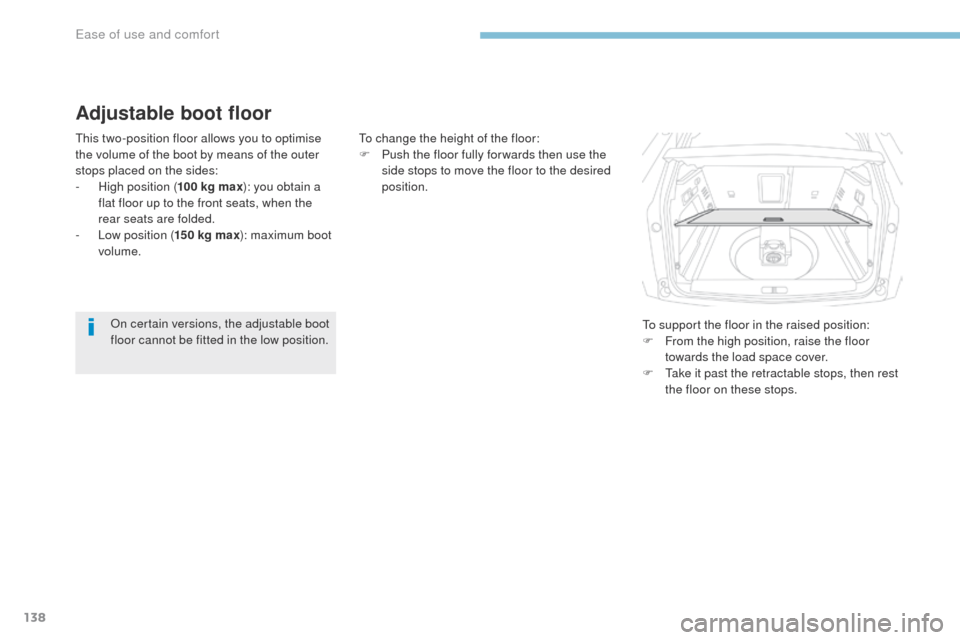
138
3008-2_en_Chap03_ergonomie-et-confort_ed01-2016
Adjustable boot floor
This two-position floor allows you to optimise
the volume of the boot by means of the outer
stops placed on the sides:
-
Hig
h position ( 100 kg max ): you obtain a
flat floor up to the front seats, when the
rear seats are folded.
-
L
ow position ( 150 kg max): maximum boot
volume. To change the height of the floor:
F
P ush the floor fully for wards then use the
side stops to move the floor to the desired
position.
To support the floor in the raised position:
F
F
rom the high position, raise the floor
towards the load space cover.
F
T
ake it past the retractable stops, then rest
the floor on these stops.
On certain versions, the adjustable boot
floor cannot be fitted in the low position.
Ease of use and comfort
Page 170 of 578
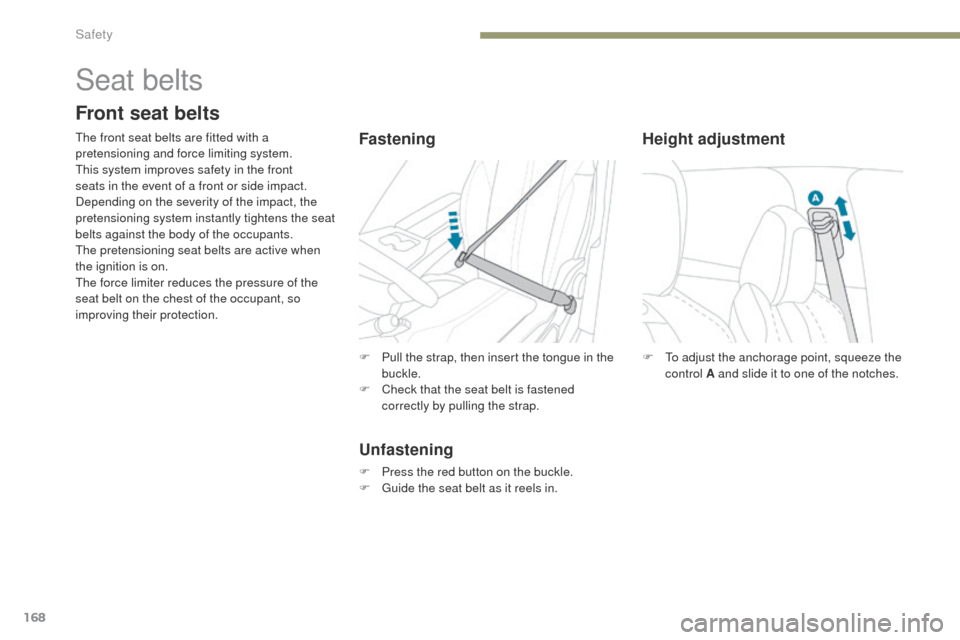
168
3008-2_en_Chap05_securite_ed01-2016
F To adjust the anchorage point, squeeze the control A and slide it to one of the notches.
Height adjustment
Seat belts
Front seat belts
The front seat belts are fitted with a
pretensioning and force limiting system.
This system improves safety in the front
seats in the event of a front or side impact.
Depending on the severity of the impact, the
pretensioning system instantly tightens the seat
belts against the body of the occupants.
The pretensioning seat belts are active when
the ignition is on.
The force limiter reduces the pressure of the
seat belt on the chest of the occupant, so
improving their protection.Fastening
Unfastening
F Press the red button on the buckle.
F G uide the seat belt as it reels in.
F
P
ull the strap, then insert the tongue in the
buckle.
F
C
heck that the seat belt is fastened
correctly by pulling the strap.
Safety
Page 171 of 578
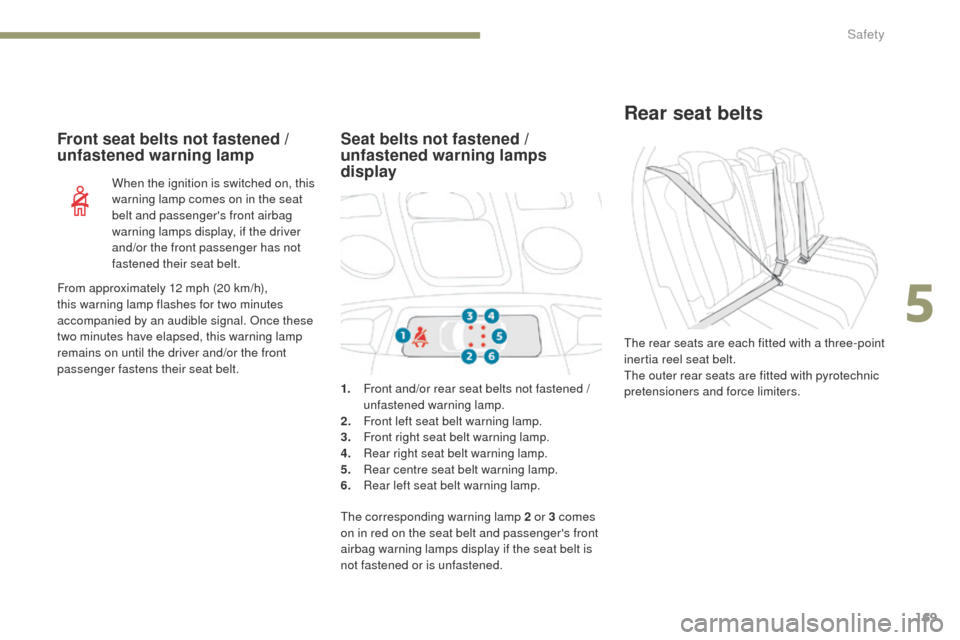
169
3008-2_en_Chap05_securite_ed01-2016
Rear seat belts
The rear seats are each fitted with a three-point
inertia reel seat belt.
The outer rear seats are fitted with pyrotechnic
pretensioners and force limiters.
Front seat belts not fastened /
unfastened warning lamp
When the ignition is switched on, this
warning lamp comes on in the seat
belt and passenger's front airbag
warning lamps display, if the driver
and/or the front passenger has not
fastened their seat belt.1.
F
ront and/or rear seat belts not fastened /
unfastened warning lamp.
2.
F
ront left seat belt warning lamp.
3.
F
ront right seat belt warning lamp.
4.
R
ear right seat belt warning lamp.
5.
R
ear centre seat belt warning lamp.
6.
R
ear left seat belt warning lamp.
Seat belts not fastened /
unfastened warning lamps
display
The corresponding warning lamp 2 or 3 comes
on in red on the seat belt and passenger's front
airbag warning lamps display if the seat belt is
not fastened or is unfastened.
From approximately 12 mph (20 km/h),
this warning lamp flashes for two minutes
accompanied by an audible signal. Once these
two minutes have elapsed, this warning lamp
remains on until the driver and/or the front
passenger fastens their seat belt.
5
Safety
Page 173 of 578
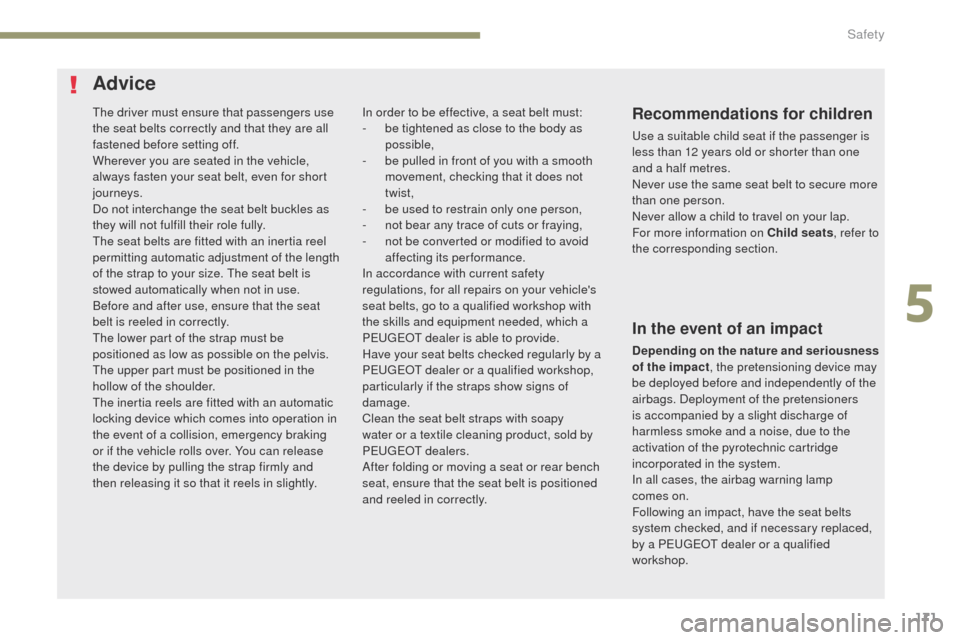
171
3008-2_en_Chap05_securite_ed01-2016
The driver must ensure that passengers use
the seat belts correctly and that they are all
fastened before setting off.
Wherever you are seated in the vehicle,
always fasten your seat belt, even for short
journeys.
Do not interchange the seat belt buckles as
they will not fulfill their role fully.
The seat belts are fitted with an inertia reel
permitting automatic adjustment of the length
of the strap to your size. The seat belt is
stowed automatically when not in use.
Before and after use, ensure that the seat
belt is reeled in correctly.
The lower part of the strap must be
positioned as low as possible on the pelvis.
The upper part must be positioned in the
hollow of the shoulder.
The inertia reels are fitted with an automatic
locking device which comes into operation in
the event of a collision, emergency braking
or if the vehicle rolls over. You can release
the device by pulling the strap firmly and
then releasing it so that it reels in slightly.Recommendations for children
Use a suitable child seat if the passenger is
less than 12 years old or shorter than one
and a half metres.
Never use the same seat belt to secure more
than one person.
Never allow a child to travel on your lap.
For more information on Child seats, refer to
the corresponding section.
In the event of an impact
Depending on the nature and seriousness
of the impact , the pretensioning device may
be deployed before and independently of the
airbags. Deployment of the pretensioners
is accompanied by a slight discharge of
harmless smoke and a noise, due to the
activation of the pyrotechnic cartridge
incorporated in the system.
In all cases, the airbag warning lamp
comes
on.
Following an impact, have the seat belts
system checked, and if necessary replaced,
by a PEUGEOT dealer or a qualified
workshop.
Advice
In order to be effective, a seat belt must:
- b e tightened as close to the body as
possible,
-
b
e pulled in front of you with a smooth
movement, checking that it does not
twist,
-
b
e used to restrain only one person,
-
n
ot bear any trace of cuts or fraying,
-
n
ot be converted or modified to avoid
affecting its performance.
In accordance with current safety
regulations, for all repairs on your vehicle's
seat belts, go to a qualified workshop with
the skills and equipment needed, which a
PEUGEOT dealer is able to provide.
Have your seat belts checked regularly by a
PEUGEOT dealer or a qualified workshop,
particularly if the straps show signs of
damage.
Clean the seat belt straps with soapy
water or a textile cleaning product, sold by
PEUGEOT dealers.
After folding or moving a seat or rear bench
seat, ensure that the seat belt is positioned
and reeled in correctly.
5
Safety
Page 178 of 578
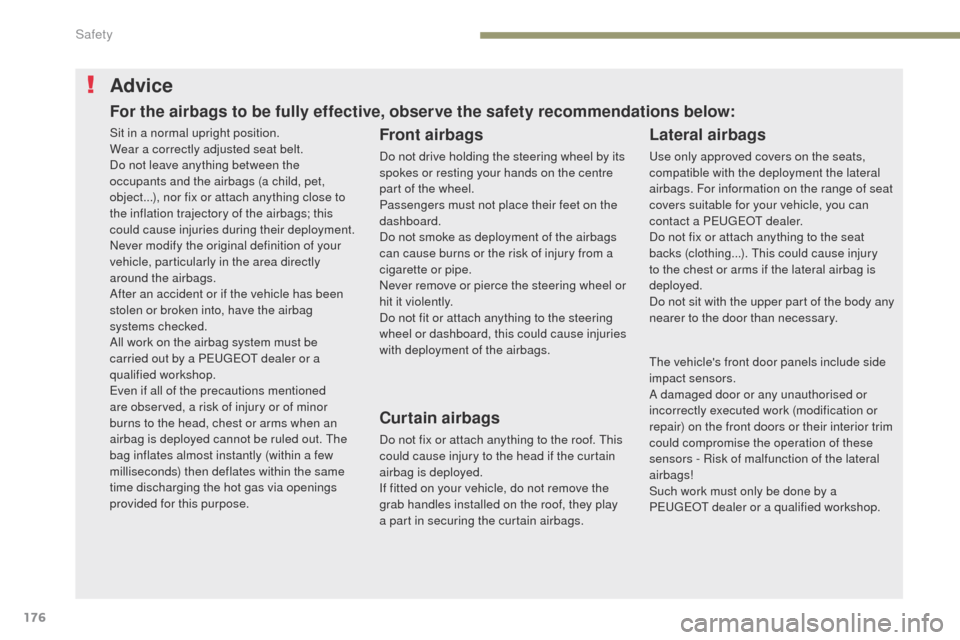
176
3008-2_en_Chap05_securite_ed01-2016
Advice
Front airbags
Do not drive holding the steering wheel by its
spokes or resting your hands on the centre
part of the wheel.
Passengers must not place their feet on the
dashboard.
Do not smoke as deployment of the airbags
can cause burns or the risk of injury from a
cigarette or pipe.
Never remove or pierce the steering wheel or
hit it violently.
Do not fit or attach anything to the steering
wheel or dashboard, this could cause injuries
with deployment of the airbags.
Lateral airbags
Use only approved covers on the seats,
compatible with the deployment the lateral
airbags. For information on the range of seat
covers suitable for your vehicle, you can
contact a PEUGEOT dealer.
Do not fix or attach anything to the seat
backs (clothing...). This could cause injury
to the chest or arms if the lateral airbag is
deployed.
Do not sit with the upper part of the body any
nearer to the door than necessary.
Curtain airbags
Do not fix or attach anything to the roof. This
could cause injury to the head if the curtain
airbag is deployed.
If fitted on your vehicle, do not remove the
grab handles installed on the roof, they play
a part in securing the curtain airbags.
Sit in a normal upright position.
Wear a correctly adjusted seat belt.
Do not leave anything between the
occupants and the airbags (a child, pet,
object...), nor fix or attach anything close to
the inflation trajectory of the airbags; this
could cause injuries during their deployment.
Never modify the original definition of your
vehicle, particularly in the area directly
around the airbags.
After an accident or if the vehicle has been
stolen or broken into, have the airbag
systems checked.
All work on the airbag system must be
carried out by a PEUGEOT dealer or a
qualified workshop.
Even if all of the precautions mentioned
are observed, a risk of injury or of minor
burns to the head, chest or arms when an
airbag is deployed cannot be ruled out. The
bag inflates almost instantly (within a few
milliseconds) then deflates within the same
time discharging the hot gas via openings
provided for this purpose.
For the airbags to be fully effective, observe the safety recommendations below:
The vehicle's front door panels include side
impact sensors.
A damaged door or any unauthorised or
incorrectly executed work (modification or
repair) on the front doors or their interior trim
could compromise the operation of these
sensors - Risk of malfunction of the lateral
airbags!
Such work must only be done by a
PEUGEOT dealer or a qualified workshop.
Safety
Page 179 of 578
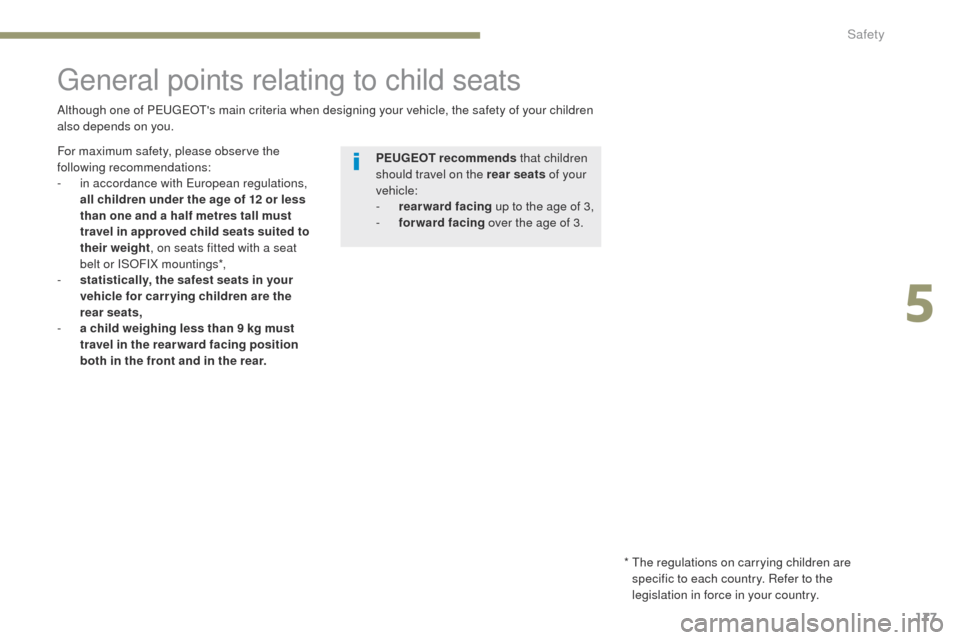
177
3008-2_en_Chap05_securite_ed01-2016
General points relating to child seats
Although one of PEUGEOT's main criteria when designing your vehicle, the safety of your children
also depends on you.*
T
he regulations on carrying children are
specific to each country. Refer to the
legislation in force in your country.
For maximum safety, please observe the
following recommendations:
-
i
n accordance with European regulations,
all children under the age of 12 or less
than one and a half metres tall must
travel in approved child seats suited to
their weight , on seats fitted with a seat
belt or ISOFIX mountings*,
-
s
tatistically, the safest seats in your
vehicle for carr ying children are the
rear seats,
-
a c
hild weighing less than 9 kg must
travel in the rear ward facing position
both in the front and in the rear. PEUGEOT recommends
that children
should travel on the rear seats of your
vehicle:
-
re
arward facing up to the age of 3,
-
fo
rward facing over the age of 3.
5
Safety
Page 180 of 578

178
3008-2_en_Chap05_securite_ed01-2016
Passenger seat in the fully back and
highest position.
Child seat at the front*
Rearward facingForward facing
* Refer to the legislation in force in your country
before installing a child seat on this seating
position. Ensure that the seat belt is properly
tightened.
For child seats with a support leg,
ensure that this is in firm and steady
contact with the floor. If necessary,
adjust the passenger's seat.
When a rear ward facing child seat is installed
on the front passenger seat
, adjust the
vehicle seat to the fully back and highest
position, with the backrest straightened.
The passenger's airbag must be deactivated.
Otherwise, the child risks being seriously
injured or killed if the airbag is deployed .When a for ward facing child seat is installed on
the front passenger seat
, adjust the vehicle
seat to the fully back and highest position,
with the backrest straightened. Leave the
passenger's airbag active.
Safety